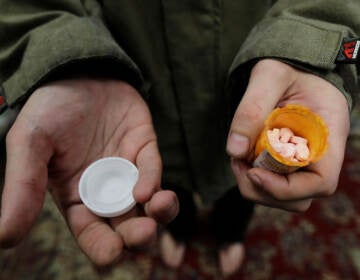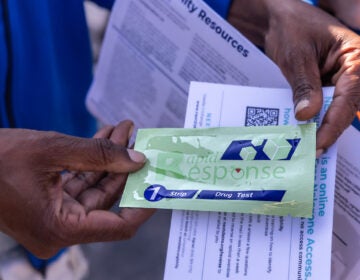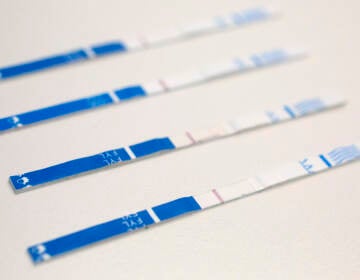‘Goliath of a problem’: Delaware overdose deaths skyrocketing even as state reaps millions from opioid settlements
Last year, 515 Delawareans died of overdoses. “It's really disheartening when you see people doing lots of work,” one victim’s father says.
Listen 1:26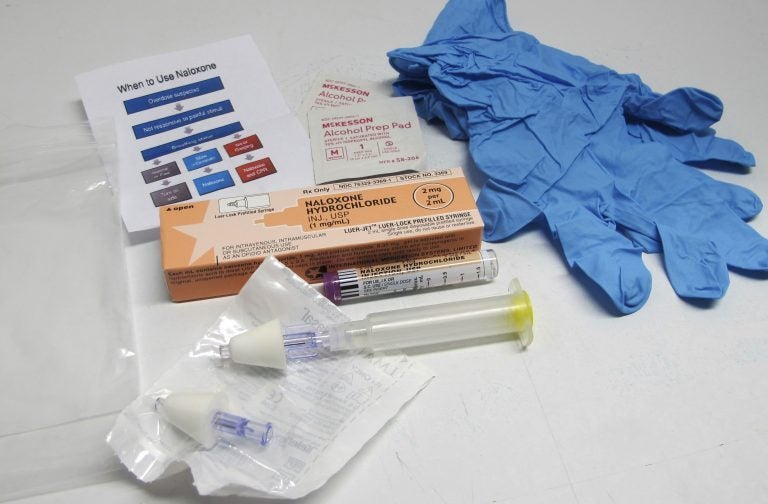
This May 13, 2015, file photo shows the contents of a drug overdose rescue kit at a training session on how to administer naloxone. (Carolyn Thompson/AP Photo, File)
Delaware overdose deaths continue to skyrocket even as state and federal officials spend tens of millions of dollars a year to keep people alive and guide them into treatment.
Those disparate realities were punctuated in recent days by two announcements from state officials.
First, state health officials announced Thursday that in November, 43 people died of suspected overdose deaths — the highest monthly preliminary number in state history and one that’s likely to be much higher once toxicology results are completed on those bodies and others not yet flagged as possible overdoses.
Health officials told WHYY News this week that by year’s end, the number of fatalities from fentanyl, heroin, and other drugs should surpass last year’s record total of 515 — nearly three deaths every two days.
In the U.S., Delaware has the third-highest overdose death rate per capita, surpassed by only West Virginia and Kentucky, according to 2020 federal statistics. Among Delaware’s neighbors, Maryland has the sixth highest rate, Pennsylvania is eighth, and New Jersey 19th.
In the wake of Delaware’s latest death toll, Attorney General Kathy Jennings announced Monday that the state’s cumulative share of national settlements from lawsuits in recent years against opioid makers and distributors is roughly $250 million. That includes some $44 million from pharmacy chains Walgreens and CVS in a deal that was just finalized, and $25 million from manufacturers Teva and Allergan that is being finalized.
The quarter-billion dollars will be received and spent over several years. The money will be distributed through a state-managed fund for a variety of inpatient and outpatient treatment and recovery programs, plus other services, including the purchase and distribution of Narcan, which can save lives by reversing the effects of an opioid overdose.
But with so many people dying with a needle in their arm or deadly powder on a nearby table, health, law enforcement, and recovery leaders acknowledge they are beyond saddened and frustrated by the relentless toll.
Don Keister runs atTAcK Addiction, which was founded after his son Tyler Armstrong Keister overdosed and died a decade ago this month. Keister says the scourge of fentanyl, which is far more deadly than heroin, has so far eviscerated the state’s ability to control the damage. Fentanyl is often mixed into heroin as well as cocaine and methamphetamine, and has been present in about 80% of deaths in recent months, state health officials say.
“It’s really disheartening when you see people doing lots of work, putting lots of money into a number of initiatives to try to get a handle on this, and the deaths keep going up,” Keister said.

“And I would really, really hope that with this money coming in, we get ideas, things that are going to have an impact on these deaths.”
Joanna Champney, director of the Delaware Division of Substance Abuse and Mental Health, shares Keister’s dismay.
“It absolutely is devastating,” Champney said.
Yet Champney says the settlement money and other state and federal dollars are helping build and expand the state’s ability to provide immediate services.
“The state has worked really hard to put an infrastructure in place where people can walk in to get behavioral health services,” she said. “That’s a really important backbone to give people a place to go.”
She noted that the state now has four so-called “bridge clinics” that can get people help almost immediately.
“People can walk in, get screenings, referrals,” she said. “They can even get immediate enrollment into medication-assisted treatment there.”
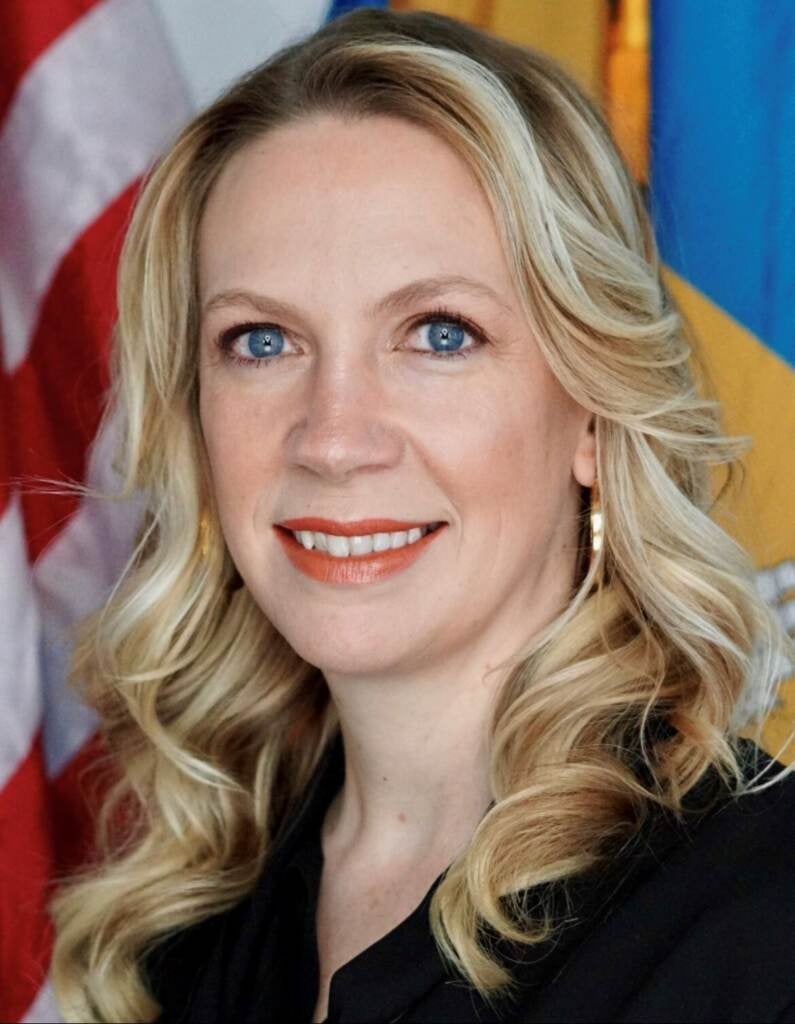
Champney said the state will soon be opening an “opioid response center” using federal grant money.
“It’s basically going to be an intelligence center where we look for the hot spots,” she said.
Once that is accomplished with geo-mapping, “we’ll be blanketing those neighborhoods with Narcan, offering that, introducing people to the bridge clinic, really trying to get out there into the community and into the areas where we know overdoses are happening,” Champney said. “So it’s a more proactive approach really to underscore the urgency of what we’re seeing.”
‘No amount of money can fully repair the damage’
Jennings said in a written statement that she realizes “the true cost of the epidemic is measured in lives, not dollars” and that “no amount of money can fully repair the damage done to our state. The task ahead of us is to save as many lives as we can; to support Delawareans in recovery; and to continue to hold Big Pharma accountable for its hand in the crisis.”
She said the financial terms of the new settlement with CVS and Walgreens, and an earlier one with Walmart, requires their pharmacies to monitor, report, and share data about suspicious activity related to opioid prescriptions.
Delaware has also received money from other opioid makers and cogs in the supply chain, such as OxyContin manufacturer Purdue Pharma as well as Johnson & Johnson, AmerisourceBergen, Cardinal Health, McKesson, Mallinckrodt, McKinsey & Co. and Endo.
Jennings’ spokesman Mat Marshall expounded on her statement and said “it’s a fair question” to ask when the money might translate into fewer funerals.
“It’s a Goliath of a problem to deal with,” he said. “So you’re going to see some lag between when resources come in, between when those resources are directed to a corrective resource, whether that’s treatment aid or any other form of abatement, and when we see results from that.”
Noting that more than 1,000 people will have died from overdoses in the state of a million people in a two-year period time — 0.1% of the population — Marshall said the situation has been “exacerbated by the introduction of fentanyl that multiplies the deadliness of some of these drugs.”
Marshall said that besides helping Delaware obtain money for treatment and other services, his office is focused on investigating and prosecuting illicit opioid traffickers dealers while helping users get the help they desperately need rather than a punitive journey through the justice system.
“We’re right off I-95,” he said. “It’s an interstate problem and in many ways a global problem. So it’s something we deal with every day.
“Our hearts are with the people who are dealing with it now and who are missing people from their family as a result of this crisis. We just want to contribute in any way we can to prevent this from getting worse.”
If you or someone you know is struggling with substance use, SAMHSA’s National Helpline is a free, confidential, 24-hour hotline that offers referrals to local treatment facilities, support groups, and community-based organizations. Call 1-800-662-HELP for more information.
WHYY is your source for fact-based, in-depth journalism and information. As a nonprofit organization, we rely on financial support from readers like you. Please give today.




